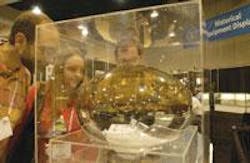This 20-in.-diameter photomultiplier tube, on loan from Hamamatsu (Hamamatsu City, Japan), is the world’s largest and was on exhibit in the historical-equipment display at the 50th annual meeting of the SPIE (San Diego, CA; July 30 to Aug. 4). It was developed for the detection of neutrinos, which create light through the Cherenkov process when they interact with water. A 50,000-gallon tank of water is located in an underground mine in Japan at a depth of about 1000 m with more than 11,000 of these tubes surrounding it (Laser Focus World, October 2000, p. 77).
A Cherenkov light used to determine the entry and exit locations of neutrinos passing through Earth made it possible to determine their origin, and measurements of solar neutrinos have determined that neutrinos have mass. In addition to this Solar Neutrino Detector from the 1980 time frame, other pieces of equipment on display included a copy of the first issue of Laser Focus from 1965, high-speed motion-picture cameras from the 1950s, and a Dolland telescope from the 1700s.
The 50th annual SPIE meeting broke records for total attendees (almost 6000) and for number of exhibitors (more than 270). Meeting organizers attributed the rise in attendance in part to the introduction of a nanophotonics symposium track this year, which included 1000 presentations. A Sunday afternoon symposium-wide nanotechnology plenary presentation by K. Eric Drexler, founder of the Foresight Institute (Palo Alto, CA), was followed on Monday morning, by seven nanotechnology plenary sessions focused on current materials research.
“As we plan for 2006, we will have a tough act to follow,” said meeting manager Marilyn Gorsuch. “But I believe we have added some valuable content this year that we will continue, and we have received enthusiastic endorsement for adding a solar-energy program to the meeting.”
A conference on organic photovoltaics was included in the program on organic photonics and electronics, chaired by Zakya Kafafi of the Naval Research Laboratory (Washington, D.C.), who was named a SPIE fellow this year. The organic photovoltaics conference also shared a joint plenary session with the 5th International Conference on Solid State Lighting, chaired by Ian Ferguson, Georgia Institute of Technology (Atlanta, GA). During that session, George Craford, CTO of Lumileds (San Jose, CA) gave the plenary talk on solid-state lighting trends and applications (see Laser Focus World, September 2005, p. 17).
About the Author
Hassaun A. Jones-Bey
Senior Editor and Freelance Writer
Hassaun A. Jones-Bey was a senior editor and then freelance writer for Laser Focus World.
